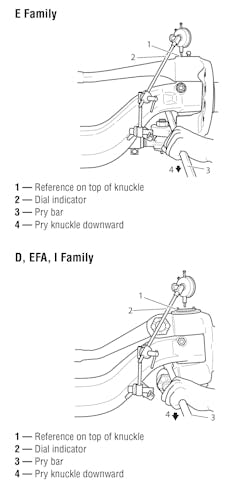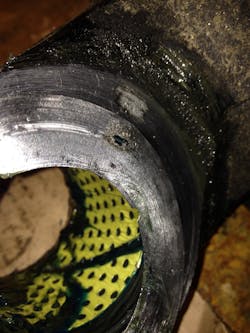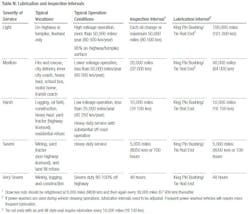The steer axle kingpin is the pivot point between the axle beam and the wheel ends. It is also the point of connection for the spindle knuckle, the wheel ends, and the steer axle. The role of the steer axle kingpin is to maintain steering geometry on the vehicle as it provides the ability for the wheel ends to turn the vehicle left or right.
Being that the steer axle kingpin is a critical component, service and maintenance must never fall behind. Replacing a steer axle kingpin can be a long and tedious procedure, but preventive maintenance practices can help ease future full-service jobs as well as prolong the life of the kingpin and extend the time between replacements. The most crucial aspect in preventive maintenance regarding the steer axle kingpin is lubrication.
Beware of the wear
Understanding the warning signs that indicate a potential steer axle kingpin issue will go a long way when it comes time to replace the kingpin itself. Should warning signs be ignored, not only will the replacement procedure become more difficult, but additional maintenance issues will need to be dealt with along with additional safety concerns as they relate to the vehicle’s ability to operate.
The first person to notice a potential steer axle kingpin issue will most likely be the driver.
“The driver can potentially feel pull or shimmy in the wheel when steering or when going straight,” says Jackie Stockwell, product manager for aftermarket front steer axle and electrification at Meritor. “It almost might feel like an alignment issue, but it could potentially be the kingpin.” Meritor is a global supplier of drivetrain, mobility, braking, and aftermarket solutions for commercial vehicle and industrial markets.
“The driver could have a difficult time steering the truck, as without proper lubrication [the] shims will not allow for easy movement of the steering,” says Scott Donnelly, aftermarket training manager, senior quality engineer, Dana Aftermarket. “In critical cases, this lack of grease can cause the shims to wear away and create catch points in the steering. These catch points would make it hard for the driver to input small corrections without first having to overcome the binding from the damaged components. The driver would have to jerk the wheel to make even small movements, which could cause a dangerous driving situation.” Dana engineers, manufactures, and distributes drivetrain and e-Propulsion systems. Dana Aftermarket brands support the passenger car and light truck, heavy duty truck and bus, and off-highway equipment markets.
“Sometimes [drivers] hear clunky noises coming out of the steer axle,” says Alejandro Ayala, senior product manager for Kaiser gaff and suspension products for STEMCO. STEMCO supplies a line of high-performance systems and components to the commercial vehicle industry.
If a driver reports any difficulty with the steering or strange noise from the steer axle, technicians should further investigate. First, a technician should check for uneven tire wear.
“With a kingpin issue, it would be inner [shoulder] tire wear,” Ayala says. “The tire, instead of being straight [and] perpendicular to the ground starts to open from the bottom out. So inner wear is most common.”.
Beyond looking for uneven tire wear, technicians can also determine a steer axle kingpin issue by performing a check on the entire wheel end.“If they have the truck up, the best way to check if [the steer axle kingpin] needs to be replaced is to lift that front axle off the ground and apply pressure to the top of the wheel and on the bottom of the wheel and check for end play,” Stockwell says. “End play is basically too much movement in the tire. Obviously, you have to turn left and right, but you don't want there to be any movement up and down. Use a dial indicator and do a proper measured check; if [end play is] over ten thousandths of an inch, we recommend you replace that [kingpin]. You might not quite feel ten thousandths of an inch [of movement], that sounds like a very small number. So that's why we recommend doing it whenever you get the opportunity to have the axle off the ground.”
Performing such a procedure with a dial indicator every time the steer axle is lifted will provide the fleet with a log of end play; staying on top of increasing end play increments can prevent tire wear and decrease tire replacement frequency.
“When [the steer axle kingpin is] new, they're going to have about three to four thousandths of an inch of play,” Ayala says. “It's not a rule, but that's in general terms. Once it hits the ten thousandths [range of] movement, those tires are going to be wearing out fast. And that's the indication you need to replace a kingpin. If you're inspecting the [movement] and logging that, you can see when your kingpin needs repair. Do you wait until the tires are worn? Or, do you put the new tires on and wear them prematurely because you already have a kingpin [that is] worn out?”
And now, the hard part
You would be hard pressed to find a technician that claims they enjoy replacing steer axle kingpins. The procedure is tenuous and time consuming, not to mention technical and precise with minimal margins for error. Though procedures for steer axle kingpin removal and installation vary from vehicle to vehicle, there are some universal steps, tips, and tricks to consider.
The first step of steer axle kingpin replacement requires the entire wheel end to be torn down and removed from the vehicle, leaving only the spindle knuckle connected to the axle beam.
Once the knuckle caps and the draw keys are removed, the kingpin itself must be extracted.
“The toughest part of this job is to see how the kingpin is going to come out,” says STEMCO’s Ayala. “Will it come out? Sometimes it is kind of frozen into the axle and it’s very hard to remove it. Sometimes, once [the technician has] removed all the components, a single tap [to the kingpin] and the kingpin falls out. That’s where the technician becomes very happy, and says, ‘Yeah!’”
However, if the kingpin is seized in the bore, extraction can be troublesome. The kingpin can become seized when humidity and debris enter the bore; over time, that contamination can lead to rust that can essentially weld the pin and bore together. Presses, hammers, and any tool at a technician’s disposal will need to be utilized in order to remove a seized kingpin. STEMCO offers the QwikeXtract King Pin Removal System, which includes a 50-ton hydraulic press to aid technicians in the removal of seized kingpins.
“One of the biggest challenges that technicians face is getting the bushing out of the knuckle without damaging the bushing bore,” says Dana Aftermarket’s Donnelly. “We recommended they use a punch to remove the knuckle and a press tool to reinstall it. It’s not a good idea to use a die grinder for removing the bushing.”
With the kingpin removed, technicians will need to clean and clear the bore before installing a new kingpin kit. With the previous kit removed and debris cleared, technicians need to measure to ensure the bore is round; a round bore will ensure a proper fit of the new kingpin kit, as well as prevent premature wear on the new kingpin.
STEMCO offers the Axle Pro Equipment (APE) to help establish a round bore and a properly snug fit for the steer axle kingpin.
“With the Axle Pro Equipment, we drill the bore and we treat it to bring it to the OE specs,” says STEMCO’s Ayala. “That bore, we sleeve it with a hardened steel sleeve that is going to be stronger than the casting of the axle, thus making the bore stronger for life. The APE is an equipment to drill that bore, align it, and then fill it with a sleeve to bring the dimensions back to where they need to be.”
Kingpin kits and installation procedures
After establishing the roundness of the bore, it is time to install a new kingpin kit. The first step in the installation process will be selecting the appropriate kingpin kit.
“The technician should reassemble the steer axle kingpin by using a kit that has all of the components included, such as Spicer genuine kits that meet OE specifications,” says Dana Aftermarket’s Donnelly. “They've been designed, developed, and manufactured to work together so technicians can be confident they are installing the same quality components as when the truck was new. Also, it is important to replace all of the wear items at once, including the bushings, seals, shim pack, thrust bearings, and kingpins.”Determining the correct kingpin kit to install on the vehicle, especially if it is the vehicle’s first steer axle kingpin replacement, may require a bit of research. Meritor offers the Xact Search feature, specifically for kingpin kits, on the MeritorPartsXpress.com platform to help mitigate mismatch kit-to-axle dilemmas.
“All you need to know is the make, model, and year of the vehicle you're working on and it will give you the kingpin kit for your application,” says Meritor’s Stockwell. “Not only that, but it will give you different bushing options. So you can choose a ream kit if you have that technical capability, you can choose a pre-sized bushing if you want that solid fit without having to ream, or you can choose a spiral bushing if you just want a quick, easy job. We also have, in our catalog search on MeritorPartsXpress.com, [the ability where] you can drill down by kingpin length, diameter, the bushing type you're looking for, [or] if you know the axle make but maybe not the model. You can drill down by all those different attributes to get to the right kingpin kit that way as well.”
STEMCO’s support team is available to assist customers in identifying the kingpin kit that they will need, says Ayala.
Installing the appropriate steer axle kingpin kit will vary from vehicle to vehicle, but there are universal aspects to installation that should be considered. It is recommended to follow the axle manufacturer’s installation procedures. Typically, installation will begin by installing the bushings into the bore.
The equipment needed to install a bushing depends on the type of bushing being installed. Bushing drivers are commonplace. If using a spiral bushing, installation can be done by hand with the use of needle nose pliers. Traditional, ream-type bushings will need to be reamed accordingly prior to install.
“Reaming requires specialty equipment as well as a very high technical capability,” Stockwell says. “It's [a] very precise process as you don't want to take out too much material because you want a tight fit in between the pin and the bushing … But if you don't take out enough, then when you push the pin in it can cause an uneven wear again between the bushing.”
Meritor offers two different types of no-ream bushings as well, including the FastSet spiral bushing which can be twisted into the knuckle by hand.
“That's the easiest way for anyone, even a new technician, to be able to complete a front steer [axle kingpin] job,” Stockwell says.
“When installing the bushings on the spindles, we always recommend doing a spindle spread [test] – pass the kingpin from one bushing to the other bushing and it should feel as a slip feel with no binding,” Ayala says. “There are two bushings per spindle, and you can check if the pin goes through one bushing or the other, but the pin should go through both bushings at the same time. Sometimes technicians forget to do this. They go and install the kingpin and finish the repair and the stiff steering continues to happen because the bushing will not align. That's a key test before you go in and complete the install.”
Installing the lip seals is another important step in steer axle kingpin installation. There is a lip seal for each bushing, facing towards the axle. The lip seal allows grease to come out from the bushing, allowing worn grease and any contaminants to be removed, while simultaneously preventing contamination from going into the bushings. As vehicles go through various environments, the axle encounters dust and moisture. If the lip seal is not properly installed, that debris enters the bushing and allows for wear and degradation.
With a round bore and properly installed bushings and seals, technicians can now follow the axle manufacturer’s guideline for assembly procedures.
Lube it or lose it
Once the knuckle is fastened to the axle beam via the kingpin, the final step in the installation procedure is to apply lubrication.
“Lubrication is key for the life of the kingpin,” says STEMCO’s Ayala.
During installation, grease is introduced at two points in the steer axle kingpin system.
“The upper and lower knuckle caps are threaded to allow for the grease zerk to be installed,” says Dana Aftermarket’s Donnelly. “The grease zerk is the entry point for greasing once the kingpin kit assembly has been completed. We recommend SAE lithium-based grade 1 or 2 [grease].”
It is required that lubrication be applied to the steer axle kingpin system beyond its initial application at the time of assembly.
“That's actually the biggest thing [in order] to keep kingpins in service longer, is making sure to do the frequent lubrication,” says Meritor’s Stockwell. “We suggest a varied schedule based on the application of the truck. For example, we recommend [for] a low mileage, hard service [truck], like a garbage truck or a frequently stopping city delivery truck, to be [greased] approximately every 15,000 miles. But a line haul or a high mileage application can be done less frequently, like at every oil change or closer to 50,000 miles.”Meritor developed a chart to establish a preventive maintenance schedule, recommending intervals at which to apply lubrication to the steer axle kingpin depending on the vocation and usage of the vehicle in service.
Fleets should also consult the Technology Maintenance Council’s Recommended Practice 651 to help understand proper lubrication intervals and guidelines.
“Maintaining proper lubrication in the system is going to help a ton and allow for a long life of the system,” Ayala says. “With proper lubrication, it even helps with the kingpin not being locked when it is time to replace it, because there was always that lubrication instead of the rust. Maintaining proper lubrication is key.”
Conclusion
Steer axle kingpin servicing is extensive. There are many different stages throughout the process, each with their own considerations to account for when establishing an efficient and effective procedure. To combat common pain points, fleets can implement practices in each of these stages that will pay dividends in the long run. Create a running log that measures end play with the wheel end, measuring end play each time the steer axle is lifted and tracking increases. Awareness of increasing end play can alert a fleet to service the kingpin prior to irreversible consequences, such as excessive tire wear.
Applying lubrication at the appropriate intervals will not only prolong the life of the steer axle kingpin, but will ensure its operational capabilities, mitigate steering difficulties, and ease future servicing when it comes time to replace the kingpin. Vigilance and discipline will win out, and a fleet’s adherence to adequate preventive maintenance will increase vehicle uptime.
About the Author
Tyler Fussner
Associate Editor | Fleet Maintenance
Tyler Fussner is Managing Editor - Community Manager at Supply Chain Connect, part of the Design & Engineering Group at Endeavor Business Media.
Previously, Fussner served as the Associate Editor for Fleet Maintenance magazine. As part of Endeavor's Commercial Vehicle Group, his work has been published in FleetOwner magazine, as well as Bulk Transporter, Refrigerated Transporter, and Trailer-Body Builders.
Fussner's May 2022 print feature 'The dawn of hydrogen trucks' was named the best single technology article in B2B by the judges of the 2022 Folio: Eddie and Ozzie Awards. Fussner was also awarded Silver in the Technical Article category for the Trade Association Business Publications International (TABPI) 2021 Tabbie Awards.
Fussner previously served as Assistant Editor for Endeavor's Transportation Group on the PTEN, Professional Distributor, and VehicleServicePros.com brands.
Fussner studied professional writing and publishing at the University of Wisconsin-Whitewater. He has experience in shop operations, is a Michelin Certified Tire Technician, and a Michelin Certified Tire Salesperson.




